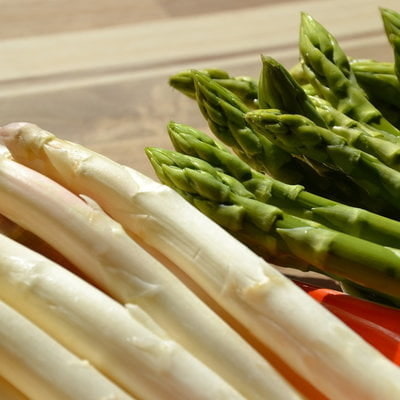
Gourmets and health-conscious cooks can hardly wait for SPARGEL time. No wonder - this "king vegetable" really has a lot to offer. Already more than 5000 years ago, the pharaohs in ancient Egypt had the asparagus spears served as a delicacy.
The difference between the three varieties lies in the method of cultivation. The color of the asparagus depends on how much light it is exposed to during its growth.
White asparagus (= pale asparagus):
Is cultivated under mounds of soil and harvested before it comes into contact with sunlight
as soon as the tip of the asparagus breaks the surface of the soil, it turns purple
mild, delicate flavor
start from the head, peel completely until the end
Green asparagus (= green asparagus)
grows entirely above ground
sunlight produces the green plant pigment chlorophyll
intense, strong and spicy flavor
peel only the lower third
also edible raw
Purple asparagus (= purple asparagus):
Special and rare form of green asparagus
grows entirely above ground
sunlight produces the purple plant pigment anthocyanins
sweet and nutty flavor
peel only the lower third
also edible raw
The good news from our dietician Verena Hut: "The great thing about asparagus is: it not only tastes excellent, but it is also very healthy!"
consists of 93% water - particularly low in calories (18 kcal/100 g)
high fiber content - positive for digestion, makes you full for a long time
easy to digest - digestible even for sensitive stomachs
rich in vitamins - A, C, E, B1, B2, folic acid
rich in minerals - potassium, calcium, phosphorus, zinc
contains secondary plant compounds - antibacterial and anti-cancer
contains aspartic acid - stimulates the kidneys, promotes urination
Due to intensive contact with sunlight, the content of health-promoting ingredients in green and purple asparagus is higher than in white asparagus.
Preparation options:
Optimal cooking water:
Ideal seasonings and herbs:

Quench the green asparagus in ice water immediately after cooking, so it keeps its intense green color
Sauté purple asparagus briefly in olive oil or process raw, so it retains its special color best (loses its purple color during cooking)
You can boil the peels and sections from the asparagus for asparagus soups, sauces or stocks.
Always eat something slightly fatty with asparagus, as vitamins A and E are fat-soluble and can therefore be better absorbed and utilized by our body!